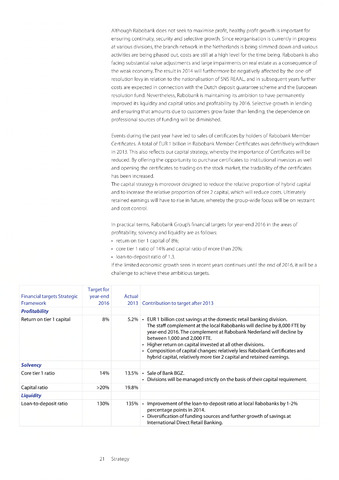Although Rabobank does not seek to maximise profit, healthy profit growth is important for
ensuring continuity, security and selective growth. Since reorganisation is currently in progress
at various divisions, the branch network in the Netherlands is being slimmed down and various
activities are being phased out, costs are still at a high level for the time being. Rabobank is also
facing substantial value adjustments and large impairments on real estate as a consequence of
the weak economy. The result in 2014 will furthermore be negatively affected by the one-off
resolution levy in relation to the nationalisation of SNS REAAL, and in subsequent years further
costs are expected in connection with the Dutch deposit guarantee scheme and the European
resolution fund. Nevertheless, Rabobank is maintaining its ambition to have permanently
improved its liquidity and capital ratios and profitability by 2016. Selective growth in lending
and ensuring that amounts due to customers grow faster than lending, the dependence on
professional sources of funding will be diminished.
Events during the past year have led to sales of certificates by holders of Rabobank Member
Certificates. A total of EUR 1 billion in Rabobank Member Certificates was definitively withdrawn
in 2013. This also reflects our capital strategy, whereby the importance of Certificates will be
reduced. By offering the opportunity to purchase certificates to institutional investors as well
and opening the certificates to trading on the stock market, the tradability of the certificates
has been increased.
The capital strategy is moreover designed to reduce the relative proportion of hybrid capital
and to increase the relative proportion of tier 2 capital, which will reduce costs. Ultimately
retained earnings will have to rise in future, whereby the group-wide focus will be on restraint
and cost control.
In practical terms, Rabobank Group's financial targets for year-end 2016 in the areas of
profitability, solvency and liquidity are as follows:
return on tier 1 capital of 8%;
core tier 1 ratio of 14% and capital ratio of more than 20%;
loan-to-deposit ratio of 1.3.
If the limited economic growth seen in recent years continues until the end of 2016, it will be a
challenge to achieve these ambitious targets.
Financial targets Strategic
Framework
Target for
year-end
2016
Actual
2013
Contribution to target after 2013
Profitability
Return on tier 1 capital
8%
5.2%
EUR 1 billion cost savings at the domestic retail banking division.
The staff complement at the local Rabobanks will decline by 8,000 FTE by
year-end 2016. The complement at Rabobank Nederland will decline by
between 1,000 and 2,000 FTE.
Higher return on capital invested at all other divisions.
Composition of capital changes: relatively less Rabobank Certificates and
hybrid capital, relatively more tier 2 capital and retained earnings.
Solvency
Core tier 1 ratio
14%
13.5%
Sale of Bank BGZ.
Divisions will be managed strictly on the basis of their capital requirement.
Capital ratio
>20%
19.8%
Liquidity
Loan-to-deposit ratio
130%
135%
Improvement of the loan-to-deposit ratio at local Rabobanks by 1 -2%
percentage points in 2014.
Diversification of funding sources and further growth of savings at
International Direct Retail Banking.
21 Strategy

